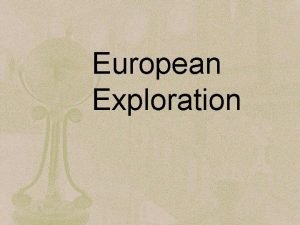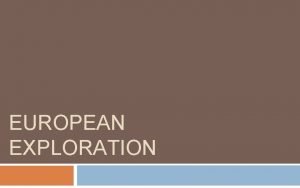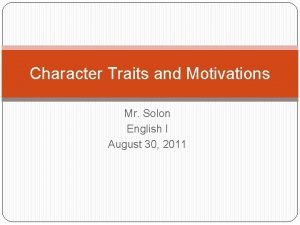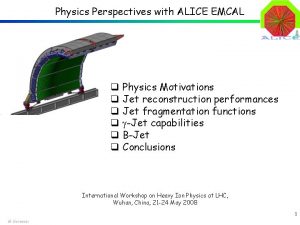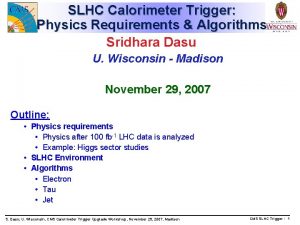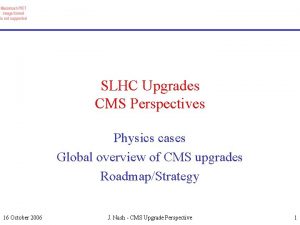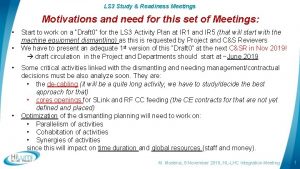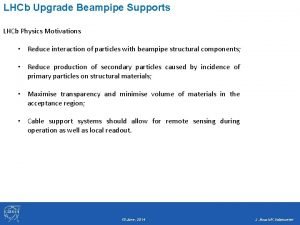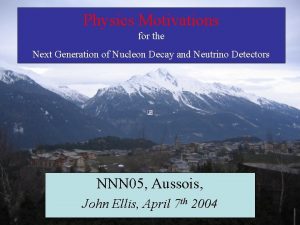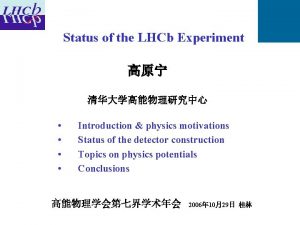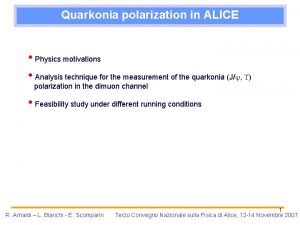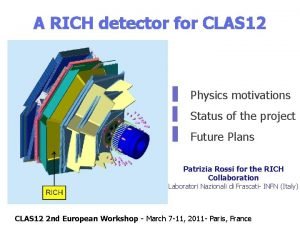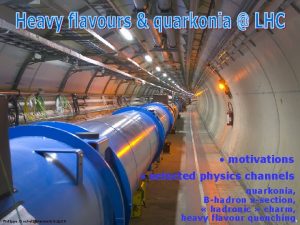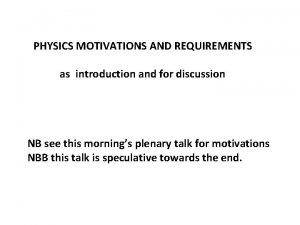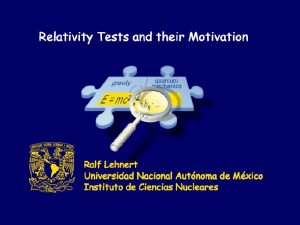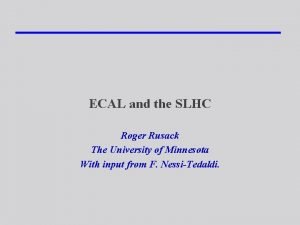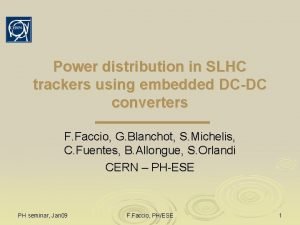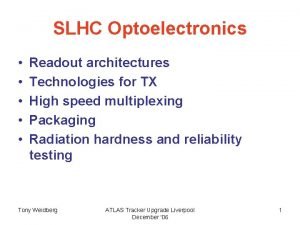Need for SLHC Physics motivations What are the






















- Slides: 22

Need for SLHC • Physics motivations • What are the limits of machine to achieve higher Luminosity. • What is needed for ATLAS to cope with the gradual increase in the Luminosity: – MUON Spectrometer projects. – Calorimeter projects. – ID projects. – Trigger projects. • Conclusions.

Motivation for SLHC • Major improvements in the determination of Quartic Gauge Boson Couplings, which allows to check on anomalies in the SM predictions. • Better determination of Higgs couplings by availability of rates in channels not open at LHC (Z-photon, MUMU, etc), as well as determination of ratios of fermions-to-vectors at 10% level. • Measurements of Higgs self coupling by the observation of double Higgs production. • Clear possibility to observe high mass resonance's (up to 2 Te. V) in V(L)-V(L) scattering.

Plans for LHC and s. LHC • SPS is old, need re-coating of beam pipe (electron cloud) and new RF to cope with instabilities. • Need LHC collimation upgrade (phase II) to reach designed Luminosity and higher. • New triplets at collision points to increase – 1) B* and in particular – 2) the Quadropule apertures (for 1 needs new SC materials, for 2) this is not needed). • One simple way to improve Luminosity is CRAB Crossing • High Luminosity, 10 E 35 strongly reduces lifetimes (~1. 5 -2 hrs); it is better to put more current and have constant (5*10 E 34) with better lifetimes, by modifying beam parameters, relatively easy with crab-crossing. • Long shut-downs strongly reduced the accumulated Luminosity, try to concentrate the activities in a few (2 -3 ) long (12 -18 months) shut-downs and regular (4 -6 months) shutdowns. • Modify the planning for the ATLAS s. LHC upgrades to match the low integrated Luminosity achieved until 2020 -2022 (start of Phase II s. LHC).

Linac 4 and SPS o Linac 4 will replace aging Linac 2 (2016, but long shut-down required) SPS repairs • Electron cloud (vacuum chamber coating) • Transverse Mode Coupling Instability (Impedance reduction and/or transverse feedback) • RF effects such as beam loading etc (redesign of existing RF or build new system) Collimation upgrade o Phase 2 collimation aims to be compatible with nominal and ultimate intensities. Present installed phase I system is compatible to less then 50% of nominal intensity (depending on assumptions on beam lifetime). o Phase 2 installation requires new secondary collimator jaws in IR 3 and IR 7; new-additional tertiary collimators and absorbers and new cryo collimators in the DS o Planning for installation in 2014 -15 requires decision in 2010 and production in 2011 (before the construction of the testing facility). o The new design using cold collimators, requires the movement of 48 SC magnets (the only regions affected are points 3 and 7) in high radiation areas. o Very likely, the project should be ready by 2016 -2017.

Crab crossings • • Crossing angle reduces luminosity Can be recovered by opposite deflection of head-tail Achieved by so-called RF crab cavities Proposed in 1998, in operation at KEKB since 2007 Could be tried in Point 4 during an early shut-down, to be included later at points 1 and 5

Long shut-downs reduce integrated Luminosity HERA • • One should try to reduce to minimum the number of long shut-downs. A long shut-down (~16 months) is a must in 2012, to be able to reach ~13 Te. V. One should try to concentrate all the work to consolidate and reach the LHC Luminosity (LINAC 4, SPS, Collimators, replacement of LHC electronics and possible IR-triplets) in one long shut-down in ~2016 -2017. The amount of integrated Luminosity until 2020 does not require a full change of the ID in the big experiments (200 MCHF/experiment), however one should try to use the shut-downs to implement partial upgrades (individual projects).

ATLAS at SLHC Consequences for ATLAS at SLHC ATLAS • One needs to sharpened the MUON LV 1 triggers thresholds (and maybe combine with rough ID LV 1 track trigger). • One would need to lower the thresholds for e-γ triggers, using more sophisticated algorithms, and also some rough ID LV 1 track trigger for E/P cut. • One should keep, as much as possible (pile-up) the Missing E(t) resolution, which means keep the rapidity coverage in calorimetry. • Needs improved forward calorimeter with high granularity to survive the high rates, but also to tag forward jets in V-V fusion. • Needs a full new ID to cope with the high occupancy, while providing a good b-tagging (pixel layers) and some LV 1 tracking. • Add an additional logic layer in the LV 1 to allow for topological combinations, as well as isolation cuts at LV 1. • Increase the latency for LV 1, in order to be able to use more sophisticated algorithms. • Increase bandwidth and look at the possibility of reducing the amount of information transmitted by putting some local intelligence. Physics requirements at SLHC • • Major improvements in the determination of Quartic Gauge Boson Couplings, which allows to check on anomalies in the SM predictions. – Need to be able to trigger on 20 -30 Ge. V leptons Better determination of Higgs couplings by availability of rates in channels not open at LHC (Z-photon, MU-MU, etc), as well as determination of ratios of fermions-to-vectors at 10% level. – Again leptons and photons (not too high E) – Also b tagging – Good lateral contain of forward shower for V-V fusion Measurements of Higgs self coupling by the observation of double Higgs production. – Again leptons and b’s If no Higgs, clear possibility to observe high mass resonance's (up to 2 Te. V) in V(L) -V(L) scattering. – Again leptons and Missing E(T)

How to improve the MUON Trigger in the forward direction (1/2 of rapidity coverage) • To include inner-most part in trigger, one needs an angular resolution of 1 mrad. • This means ~150 micron position obtained in ~400 ns, in a high radiation environment.

Short Introduction to TGC’s • • • CSC-like structure, except that anode-to -cathode distance=1. 4 mm, while anodeto-anode distance=1. 8 mm. Anode wires sandwiched between 2 high resistive layers. Readout behind resistive layers (strips, pads) or anodes. Operating voltage: 2. 9 -3. 0 KVolts. Gas: CO 2 -n Pentane (55%-45%): n Pentane increases the ionization, while absorbing the photons in the avalanche. Graphite 1. 4 mm – This provides high gain, without sparks. – N-Pentane acts also as cleaning agent (no major wire deposits after 6 Coulomb/cm). – For a small volume, one can afford to use flammable gas, and take precautions for leaks. C-H 3 chains provide a good quencher, and avoids other problems. Wires in non-irradiated And Irradiated areas

The detectors will have to operate in a high radiation background Monitor Lead Co-60 neutrons shielding L Cosmic ray Lead absorber Prototyp e Detected photons/cm^2 no hit screen hit cosmic 0. 55 8 13 20 26 KHz/cm^2 efficiency[%] efficiency Vs. rate 100% 90% 80% 70% 60% 50% 40% 30% 20% 10% 0% 100 80 60 40 20 0 35 55 75 Detected rate [Hz/cm^2] Detected 5 Me. V neutrons/cm^2

Use fast digital signals for trigger Resolution matches the needs for SLHC (200 microns for a package of 2 detectors 200 mm apart). Each package should contain ~4 detectors due to background hits

Micromegas: new technology that could be used in the forward region

Calorimetry at SLHC • • • Improve the LV 1 electron and jet measurements by sending all data to provide finer cluster and better electron identification (main emphasis on much larger bandwidth and very fast processors). Major modifications to the very forward calorimeter, to cope with the very high rates, as well as a finer lateral granularity, to better tag V-V fusion. Replacement of gap and cryostat scintillators to help also in misidentification of electrons in transition region. Various R&D projects on ensuring survival at very high neutron fluxes. R&D on the development of optical transmission elements and back-end electronics. R&D on the very forward calorimeter options

Calorimetric trigger is based on coarse isolation • With the increase of Luminosity (SLHC), pileup plays a very important role and will reduce the trigger sharpness.

Proposed solution: send all data via fast links • Progress has been made in development of radtolerant 10 Gb/sec optical links. • Many simulations are being done to confirm that one can obtained a trigger consistent with the timing requirements.

Very forward calorimeter and radiation problems • Simulations show that 12 Cu disks with 11 detector planes reduces energy deposit in FCAL by 45%. • Real detector equipped with diamond sensors constructed and tested at TRIUMF: – Total irradiation of 2 X 10 E 17 p/cm² show final amplitude 5% of the initial, with relatively small changes from 10 E 17 onwards.

New ID for SLHC • • More Pixel layers for btagging. Possibility of introducing a LV 1 track trigger to combine with Calorimeter for E/P cut in e ID. Layout to ensure 9 hits/plane. Detector should survive total radiation dose from 3, 000 fb¯¹ (or 1. 3 X 10¹⁵n/cm² in innermost Strip layer) Many R&D projects, from detectors to optical transmitters. Two main R&D projects on powering: serial and DC-DC convertors. Many R&D projects for innermost Pixel layer, including: – 3 D – Diamond – Gossip

Irradiation tests have been performed for future PIXELS • Planar n-bulk pixel sensor response after being irradiated with 2 X 10¹⁶ nₑ/cm²

Staves and modules have been constructed to test concepts • Staves and modules have been constructed and tested with serial power, showing good results

4 double-sided modules produced at Uni. GE 2 double-sided modules produced at KEK • The Uni. GE and KEK modules are working with ENC noise of ~570 e. • The noise occupancy is below 10¯⁷ at 80 m. V, while 1 f. C threshold is at ~120 m. V.

New LV 1 Trigger for SLHC • Include a new element in front of the CTP, that will allow for topological combinations of: – ID LV 1 tracks with electron clusters, with E/P matching. – ID LV 1 tracks with MUON candidates with P matching. – Isolation requirements from jets for lepton candidates. – More flexibility to adapt to the physics. – Simulation of the various performances will start soon.

Conclusions • There is a lot of interesting Physics that would allow the LHC produce interesting results until the end of 2020’s. • A substantial amount of detector R&D work is ongoing, that will allow the experiments (ATLAS) to cope with the SLHC Luminosity. • Also Latin-American countries are participating in this effort and have been part of the publications.
 Insidan region jh
Insidan region jh Motives for imperialism
Motives for imperialism Imperialism asia
Imperialism asia What did samuel de champlain accomplish
What did samuel de champlain accomplish Gold glory and god
Gold glory and god Motivations for imperialism in asia
Motivations for imperialism in asia Balboa expedition
Balboa expedition English motivations for settlement
English motivations for settlement Prestige motivation adalah
Prestige motivation adalah God gold and glory motivations for the age of exploration
God gold and glory motivations for the age of exploration Buying motivations
Buying motivations Character traits and motivations
Character traits and motivations University physics with modern physics fifteenth edition
University physics with modern physics fifteenth edition Physics ia example
Physics ia example Modern physics vs classical physics
Modern physics vs classical physics Modell för handledningsprocess
Modell för handledningsprocess Varför kallas perioden 1918-1939 för mellankrigstiden?
Varför kallas perioden 1918-1939 för mellankrigstiden? Informationskartläggning
Informationskartläggning Stål för stötfångarsystem
Stål för stötfångarsystem Vishnuismen
Vishnuismen Cks
Cks Kyssande vind
Kyssande vind Inköpsprocessen steg för steg
Inköpsprocessen steg för steg






